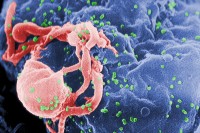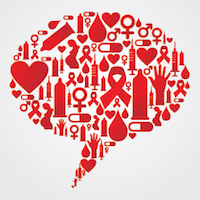- Designed for older teen and adult audiences
- Reviews the facts about the Hepatitis C virus.
- Informs about liver function, transmission of the virus, and effective prevention techniques
HCV 101




HIV (Human Immunodeficiency Virus) is a virus that attacks the human immune system and can lead to a diagnosis of AIDS (Acquired Immune Deficiency Syndrome). Every person with an AIDS diagnosis has HIV, but not everyone with HIV has AIDS.
HIV attacks specific immune system cells — the T-cells or CD4 cells. These cells are critical to fighting off new infections and diseases. HIV invades these cells and uses them to make more copies of itself, and then destroys them. Over time, HIV destroys so many cells that the body is not able to fight off diseases and infections. When this occurs, a person is given an AIDS diagnosis.
There is no cure for HIV. But, this disease is preventable. By
However, with proper treatment with “antiretroviral therapy” many people living with HIV can live longer and healthier lives.
HIV (Human Immunodeficiency Virus) is transmitted only through four fluids:
Transmission of HIV can only occur when an HIV-infected body fluid enters the body through a port of entry (examples: vagina, anus, veins, mouth, direct access to tissue).
You cannot get HIV through touching, kissing, sharing food or beverages, or being friends with someone who is HIV positive.
Safer sex practices are ways to reduce the risk of becoming HIV positive. These include using barrier methods, knowing the HIV status of your partner, minimizing higher risk sexual and/or drug use behaviors, and getting tested for HIV and other STIs.
Safer injection practices are ways to reduce the risk of becoming HIV positive through needles. These include using clean needles and works every time you inject and getting tested for HIV and Hepatitis C.
HIV (Human Immunodeficiency Virus) is transmitted only through four fluids:
Transmission of HIV can only occur when an HIV-infected body fluid enters the body through a port of entry (examples: vagina, anus, veins, mouth, direct access to tissue).
You cannot get HIV through touching, kissing, sharing food or beverages, or being friends with someone who is HIV positive.
Safer sex practices are ways to reduce the risk of becoming HIV positive. These include using barrier methods, knowing the HIV status of your partner, minimizing higher risk sexual and/or drug use behaviors, and getting tested for HIV and other STIs.
Safer injection practices are ways to reduce the risk of becoming HIV positive through needles. These include using clean needles and works every time you inject and getting tested for HIV and Hepatitis C.

HIV 101 is an interactive workshop designed to inform and educate the public on the basics of HIV and Hepatitis C (HCV) transmission, prevention and related stigmas.
Each HIV 101 presentation focuses on the following information: How HIV and HCV are transmitted, ways to address/reduce HIV and HCV-related stigma, ways to prevent/reduce new HIV and HCV infections, and how HIV and HCV cannot be contracted.
These presentations can be adapted to fit the needs and age level of the audience. They are an excellent complement to a comprehensive HIV/AIDS curriculum and help instructors fulfill the Oregon Department of Education Infectious Diseases requirement.
If you are interested in a presentation, please fill out the form below.
[contact-form to=’wrosenthal@hivalliance.org’ subject=’HIV 101 Presentation Inquiry’][contact-field label=’Name’ type=’name’ required=’1’/][contact-field label=’Phone Number’ type=’text’/][contact-field label=’Email’ type=’email’ required=’1’/][contact-field label=’Organization’ type=’text’/][contact-field label=’Comment’ type=’textarea’/][/contact-form]

Our Speakers in the Schools program has been providing HIV-positive speaker presentations in Lane County for over ten years. Their compelling presentations tell the story of their lives before, during, and after their diagnosis. The presentations are designed to increase compassion for people living with HIV/AIDS, address the complex reasons people are at risk for HIV, and inform students about the importance of harm reduction and prevention services. Speakers are also trained to answer questions and provide information about HIV transmission, risk assessment, and safer-sex techniques. The presentations are between 1-1.5 hours.
To schedule a speaker, contact Walter Rosenthal, Education Coordinator, or fill out the form below. Please schedule at least two weeks in advance.
[contact-form to=’wrosenthal@hivalliance.org%26#x002c; phansen@hivalliance.org’ subject=’SIS presentation request’][contact-field label=’Name’ type=’name’ required=’1’/][contact-field label=’Email’ type=’email’ required=’1’/][contact-field label=’Phone Number’ type=’text’ required=’1’/][contact-field label=’Organization’ type=’text’/][contact-field label=’Please enter information about your presentation request (preferred dates%26#x002c; etc.)’ type=’textarea’ required=’1’/][/contact-form]

[timeline src=”https://docs.google.com/spreadsheet/pub?key=0Albo6DgdrXfSdENQNlBRVlUwNHE4WVZad0FzeGZ1WXc&output=html” width=”100%” height=”650″ font=”DroidSerif-DroidSans” maptype=”watercolor” lang=”en” ]